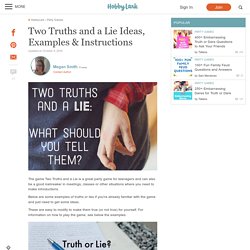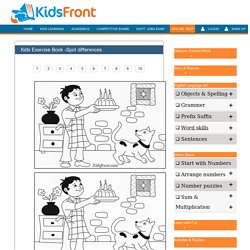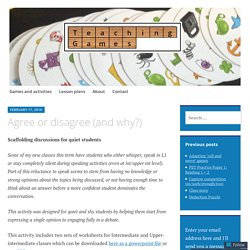

Discussion. Two Truths and a Lie Ideas, Examples & Instructions. The game Two Truths and a Lie is a great party game for teenagers and can also be a good icebreaker in meetings, classes or other situations where you need to make introductions.

Below are some examples of truths or lies if you're already familiar with the game and just need to get some ideas. These are easy to modify to make them true (or not true) for yourself. For information on how to play the game, see below the examples. This game is also called Two Truths, One Lie or Two Truths and One Not. It extremely easy to play and doesn't need any equipment or supplies, only your imagination. You can play with any number of people. Each person in the group gets a turn.When it is your turn, tell the group two things about yourself that are true and one thing that is untrue (this is your lie).Try not to tell both of your truths first and then the lie because that makes it easier to guess (see below for some more game strategies).Mix the order up each time it is your turn. Strategy #1 Strategy #2. The Only List of Would You Rather Questions You'll Need. Share on StumbleUpon0 shares on StumbleUpon Would you rather questions are a great way to get a conversation started in a fun and interesting way.

And it’s easy to get into some amazing conversations by just asking “why” after a would you rather question. Katherine Bilsborough: A simple idea - The Weekend Game. A simple Idea For me, the best classroom activities are usually the most simple, requiring little or no preparation time and few or no materials.

They are activities that can be adapted to use effectively with groups of different sizes, levels or ages and they can be used again and again even with the same students. The Weekend Game ‘The Weekend Game’ falls into all of those categories. It’s an activity I’ve been doing for decades. Preparation time: 0Materials: 0Suitable for: Most ages, most levels. ESL Conversation Questions - PRINT DISCUSS. Find Differences - Find the Difference Games, Spot the Difference Games.
Online Test Kids Exercise Book -Spot differences Print Spot the differences for Kids Discover Colorful World + Story & Rhymes+ English Language Art Maths Mania Learn with Fun+ Activities & Puzzles+ Subjects Kids Learning Academics Competitive Exams Govt.

Copyright © 2017 Kidsfront.com | Terms Of Use. Change place, change face. Spot the Difference Worksheets. ESL Discussions: English Conversation Questions / Debates: Speaking Lesson Activities. Conversation Questions for the ESL/EFL Classroom. If this is your first time here, then read the Teacher's Guide to Using These PagesIf you can think of a good question for any list, please send it to us.
ESL Conversation Questions and Teacher Resources. Agree or disagree (and why?) Scaffolding discussions for quiet students Some of my new classes this term have students who either whisper, speak in L1 or stay completely silent during speaking activities (even at int/upper int level).

Part of this reluctance to speak seems to stem from having no knowledge or strong opinions about the topics being discussed, or not having enough time to think about an answer before a more confident student dominates the conversation. This activity was designed for quiet and shy students by helping them start from expressing a single opinion to engaging fully in a debate. This activity includes two sets of worksheets for Intermediate and Upper-intermediate classes which can be downloaded here as a powerpoint file or as a PDF. The following plan is based on an intermediate level class of 10 to 12 students. Stage 1 – Agree or disagree The students are given a handout with 12 statements. Required watching for any TED speaker: The science of stage fright. One thing can strike fear into the heart of the fiercest warrior, the most powerful CEO and the smartest person in any given room: having to speak in public.

The thought of it makes the palms sweat, the heart beat faster and the limbs start to shake. An estimated 75% of people have a fear of speaking in public, and it’s something that nearly everyone who takes the TED stage must work hard to overcome. This TED-Ed lesson, the science of stage fright, just might help. In the lesson — which is taught by educator Mikael Cho and directed by animator Robertino Zambrano of KAPWA Studioworks — looks at stage fright not as an emotion, but as a physiological response. In other words, it’s not so much something to be overcome as to be adapted to. “Humans are wired to worry about reputation. The lesson explains exactly what happens in the body before speaking in public and, of course, gives suggestions on how to calm stage fright.
Icebreakers for Teens. One of the first steps in forming a group is having the participants find commonality, and you can do this with icebreaker games.

Teenagers often find icebreakers a fun way to introduce themselves, especially if they are self-conscious about speaking in front of a group. Top Ten Icebreakers for Teens You can use the following icebreakers for teens as written, or you can alter them to fit the number of participants you have or the theme of the group. #1 Human Bingo Take a pile of note cards, and write a teen's name and a question on it.
. #2 Teen Interviews Divide the teenagers into pairs. Oral English Activities. Conversation starters.